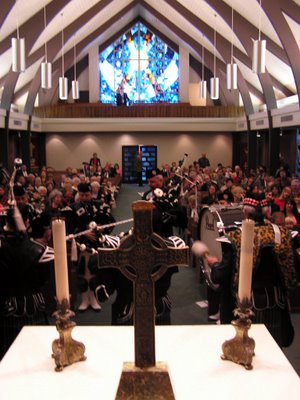on Kirkin' 'o the Tartans Sunday


.: Batesville, Mississippi | Presbyterian Church (USA) :.


March 14, 2006
The Mississippi House has adopted an official state tartan — a distinctive fabric of woven colors and stripes that can be worn as kilts, skirts and vests.
In Scotland, district tartans signify a region of the country and clan tartans signify a particular family.
The House passed a resolution today designating the tartan. The proposal now goes to the Senate for consideration.
Under the resolution, Mississippi's official tartan would be a plain design of dark green, which signifies the forests of pine and evergreen leaves of the Magnolia; light green for the leaves of the great Southern oaks; blue for the waters of the Mississippi River and the state's many lakes; red for the color in state flag and the bloodshed in the state's historic past; white for the sands of the Mississippi Gulf Coast and the cotton fields; and yellow for the heart of the Magnolia, the state flower.
Anyone can wear a tartan, but more than one design should not be worn at the same time, backers said.
About 24 other states and some major cities have their own design, supporters said. Iowa adopted a state tartan in 2004.
The resolution, noting that the observance of Tartan Day is April 6, said the "state of Mississippi possesses a rich history filled with the character and strength of a truly diverse population, including many Scots and Scotch-Irish."
The resolution says Mississippi has 38 towns and cities with names appearing on the map of Scotland and 67 towns, cities, and counties with the names of Scottish families who came to America.
The resolution notes that the significance of April 6 dates back to the 1320 signing of the Declaration of Arbroath, the Scottish Declaration of Independence, which the proposal says was used as the model for the American Declaration of Independence. ///
~*~
It sounds like our Kirkin' o' the Tartans service is getting results in Jackson.
Peace,In the United States, the mainline (also sometimes called mainstream ) churches are those Protestant denominations with moderate theologies which attempt to be open to new ideas and societal changes without abandoning what they consider to be the historical basis of the Christian faith. They are neither the more liberal groups such as Unitarian Universalism nor fundamentalist in their beliefs. These groups have been more open to demands for the ordination of women. They have been far from uniform in their reaction to the gay rights movement, but have not rejected it dogmatically in the way that it has been by the Catholic Church and the more conservative Protestant churches. They take a moderate view with regards to military service – all provide chaplains to the US Armed Forces and none are historically peace churches except possibly the Church of the Brethren – but all express reservations about aggressive use of military force for any reason.
The hallmark of the mainline churches would seemlingly be moderation. Only a few members or pastors in them would condemn the use of alcohol in moderation. Their theologies tend to be moderate and influenced, consciously or not, by the higher criticism. Most ministers and most members seem to be comfortable with modern-language (including inclusive language) translations of the Bible.
The history of Scotland begins around 10,000 years before the present day, when modern humans first began to inhabit Scotland after the end of the Devensian glaciation, the last ice age. Of the Stone Age, Bronze Age, and Iron Age civilisations that existed in the country, many artefacts remain but few are of writing.



